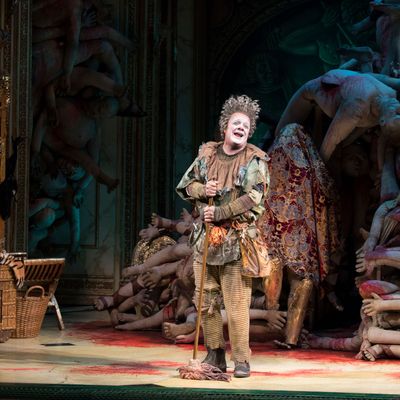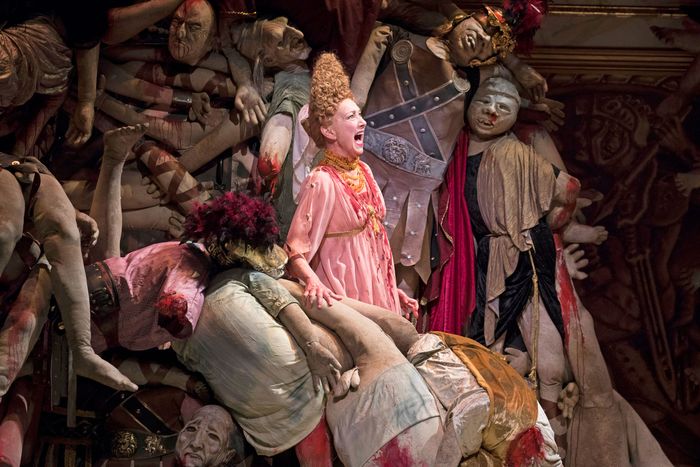
The most difficult challenge in designing the set for Gary was probably the pile of bodies. Taylor MacÔÇÖs play is a cheeky, comedic sequel to Titus Andronicus, starring Nathan Lane as ÔÇ£Gary,ÔÇØ formerly an unnamed clown mentioned briefly in ShakespeareÔÇÖs bloody tragedy, now promoted to the cleaning crew, and he arrives onstage to confront a gigantic heap of corpses. To be clear, this is a comedy, so GaryÔÇÖs design team had to find a way to be gory without alienating the audience. ÔÇ£There was enormous concern about all the bodies onstage and how macabre it would be,ÔÇØ says Santo Loquasto, the prolific scenic designer who was recently nominated for a Tony for his work. If the bodies looked too realistic, the audience would be distracted by a massacre, and if they looked too silly, there wouldnÔÇÖt be pathos. ÔÇ£I would like to think we found the line where itÔÇÖs the New Yorker cartoon about Titus Andronicus.ÔÇØ
The tone was a issue continually faced by GaryÔÇÖs design team, as Loquasto worked with lauded costume designer Ann Roth (nominated twice this year for her work on Gary and To Kill a Mockingbird) and props supervisor Ray Wetmore to conjure a setting that was vulgar, gruesome, and splendid at all once. With the stage design, Loquasto wanted to reference the classic Hollywood swords-and-sandals films by the likes of Cecil B. DeMille. ÔÇ£GaryÔÇÖs red curtain and the way itÔÇÖs hung and the motifs on it, I think, conjures up that world,ÔÇØ Loquasto says. The proscenium arch includes a statue of Romulus and Remus, added at the encouragement of producer Scott Rudin. ÔÇ£Scott, of course, loves an embellished proscenium arch more than anyone I know,ÔÇØ Loquasto says.
For the costumes, Roth also looked to film, specifically to Italian ones like Fellini Satyricon, which helped inspire the outfit and elaborate headdress worn by Julie WhiteÔÇÖs character, Carol. Roth also referenced those films in her designs for Kristine NielsenÔÇÖs maid and LaneÔÇÖs clown turned maid (turned aspiring fool), as well as whatever historical depictions she could find of ordinary RomansÔÇÖ costumes. To age the fabric, she took it to ÔÇ£people who do it better than anybody, and I donÔÇÖt give their names out because I donÔÇÖt want anybody else to get those secrets.ÔÇØ
Days before Gary went into preview performances, one of its stars, Andrea Martin, dropped out when she got hurt during rehearsals. Nielsen, whoÔÇÖd originally played the midwife, stepped into MartinÔÇÖs role, and Julie White joined the show to replace her. That meant new costumes and wigs, as well as figuring out which props would work best for each actor. For NielsenÔÇÖs costume, specifically, Roth points out that she had to be inventive. ÔÇ£Anything you saw in any museum, you couldnÔÇÖt do a play in,ÔÇØ Roth says, pointing out that a lower-class Roman woman would have been wearing no more than two tattered pieces of fabric. ÔÇ£The serfsÔÇÖ clothes are practically nothing, and the underwear is practically nothing. So naturally, I had to fake that, and that was fun.ÔÇØ So how do you fake a maidÔÇÖs costume? ÔÇ£I gave her some funny green pants,ÔÇØ Roth says. ÔÇ£I mean, it looks like gangrene under there.ÔÇØ
If youÔÇÖre building a world full of cadavers, youÔÇÖre also going to have to move them, as well as their various parts and limbs, which falls to the props department. Wetmore, working with Loquasto as well as director George C. Wolfe, took the ideas for bodies to the New YorkÔÇôbased Jerard Studios to pattern out all the different types of bodies needed in the show, some of which have to perform other bodily functions.
ÔÇ£We have the body that pees,ÔÇØ Wetmore says. ÔÇ£We have bodies with entrails. The interesting thing about it was mechanizing the gore to make it work every night.ÔÇØ The entrails, for instance, are wound around a spindle inside the body so they can be packaged easily and pulled out quickly. ÔÇ£During pre-production, there were some of the funniest conversations I have ever had,ÔÇØ Wetmore says. ÔÇ£Normally, we talk about, ÔÇÿOh, five plates have to break onstage. How do we make those plates break?ÔÇÖ Here, the challenge was, how do you pull 20 feet of intestines out of someone?ÔÇØ
The other key aspect of gore, of course, is blood. As with the bodies, GaryÔÇÖs design team spent a lot of time figuring out the right line to toe between thrilling and disgusting. ÔÇ£We knew that wanted to have blood in the show, and this means paint and gore on the bodies,ÔÇØ Wetmore says, ÔÇ£but we started with not a lot of it, and then every few days you add a little bit, you add a little bit, you add a little bit, because itÔÇÖs easier to add than to take away.ÔÇØ The blood itself falls on what Wetmore calls the ÔÇ£camp-gruesomeÔÇØ side of the spectrum, which means that within the stains, youÔÇÖll see glitter and sequins, ÔÇ£which makes it whimsical. In a way.ÔÇØ
Liquid blood shoots out of Julie WhiteÔÇÖs characterÔÇÖs neck during the prologue. Before White learned how to control the splatter, there was a ÔÇ£splash zoneÔÇØ in the front rows where audience members were getting spattered. While the team eventually cut down on the amount of blood onstage during previews, the stage still has a trough covered with grating at the front of the stage to catch the mess as itÔÇÖs swept away. The actors can clean up with water and shaving cream, though getting it out of costumes is difficult. ÔÇ£ThereÔÇÖs a blood that comes from England that is very, very pricey, but itÔÇÖs a secret formula because it comes out [of clothes],ÔÇØ Roth says. ÔÇ£I knew about it for years, and we got it.ÔÇØ



